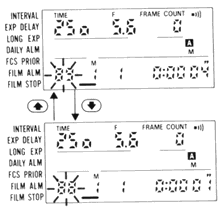![]()
1. Make sure the shutter release
buttons on the camera and MF-24 are locked. Be sure the camera's film advance
mode selector is at L (for lock) and the red dot on the MF-24's on/off dial is not
set at white index line. To turn on/off dial, push the lock release button and the
camera's film advance mode selector at L, MF-24 is off regardless of MF-24's on/off
dial settings.
2. Open the rear cover. Set the take-up and supply open/close knobs to ''OPEN"
and pull up the rear cover latch to pop open the cover.

4. Pull out the cassette spindle knob
at the bottom of the cassette compartment on the supply side.
5. Load supply cassette. To load
the cassette, make sur the two pins on top of the cassette slide into the cut out
inside the cassette compartment. As the cassette spindle knob returns to it original
position by spring force, continuously pulling up until the cassette is properly
seated. Then repeat step 4 and 5 for the cassette on the take-up side. Cassette spindle
knob does returns to its original position, jiggles the cassette right and left into
correct position.

 |
6. Confirm cassette positions. When the cassettes are loaded in their correct position, the red dots on the lower part of the outer shells of the cassettes line up with the white lines on the cassette chambers. |
7. Take up film slack. Rotate the cassette spindle knobs outwards to take up the film slack.
 |
8. Replace rear cover. Depress the locking catch on the hinge and replace the rear cover in the same manner used to attach the standard camera back. |
9. Close rear cover. push the cover firmly until it clicks.
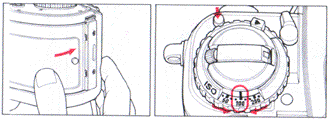 |
10. Set the camera's film speed dial to a manual setting. While pressing the lock release, set the film speed dial to the ISO number of your film. |
 |
11. Set the open/close knob to "CLOSE" position. Turn both open/close knobs to "CLOSE" to ensure smooth film transport. Rotate the cassette spindle knobs once again to take up any film slack inside the cassettes. |
* It it is difficult to rotate the open/close knob, confirm that cassettes are correctly loaded and that deformed or damaged cassettes are not used.
12. Unlock the shutter release buttons on the camera and MF-24. Set the camera's film advance mode selector to S, CH, CL or CS, and set the MF-24's on/off dial so the red dot aligns with the white index line.
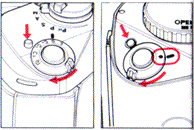 |
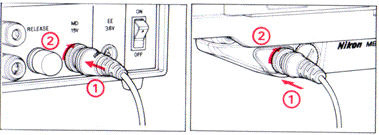 |
NOTE; With MB-22, connect power supply. Using Nikon Connecting Cord MC-1 1, connect the motor drive output lack on the MA-4 and the external power terminal on the MB-22's base portion (MB-22B). |
![]()
Frame Counters The MF-24 lets you
choose from two types of frame counters, subtractive or additive. The type selected
appears on the MF-24's LCD panel. To activate the LCD panel display, press any control
button. The frame count display will appear, "0" for additive type, "FUL"
for subtractive type. With the subtractive frame counter, an arrow (subtractive frame
counter indicator) also appears. The display will remain on for approx. 8sec. (or
approx. 16sec. when camera's meter is on).
 |
To change the frame counter (from additive type to subtractive type, or from subtractive type to additive |
* Initially, the additive-type frame
counter appears in the LCD panel.
* With the MF-24 attached to an F4/F4s camera, the frame counter on the top of the
camera body will not operate.
* If the Film Alarm function indicator or Film Stop Ii it iction indicator appears
on the LCD panel, the frame! counter display blinks. To stop the blinking, views
the MOD button,
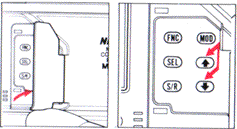 |
 |
* The frame counter can be changed from additive type to subtractive type, or vice versa, during shooting (in mid-roll) |

Additive-type frame counter The additive-type frame counter starts from "0."
After making six blank exposures, " 1 " appears and the number increases
by one each time you release the shutter, until you reach "250." When you
have taken 250 frames, "FUL" appears and stays on the LCID panel, even
if you take more than 250 trames. The reading automatically resets to "0"
when the rear cover is opened. In multiple exposure shooting, note that both frame
counters (on the MF-24's LCD panel and inside the camera's viewfinder) advance each
time the shutter is released, even though the film does not advance. Also note that
data will be imprinted each time you release the shutter on the same frame.
The subtractive-type frame counter The subtractive -type frame counter shows
the number exposed frames remaining. The reading starts from "FUL.". After
you make six blank exposures, "250" appears and the number decreases by
one each time release the shutter down to "0." If you take more than 250
frames, "0" will remain on the LCD panel. The reading automatically resets
to "FUL" when the cover is opened.

Making Six Blank Exposures The camera's auto film advance does not work with the MF-24. To make the six blank exposures, depress the M F-24's shutter release button six times until "1" appears in the additive-type frame counter or "250" appears in the subtractive -type frame counter. While making blank exposures, make sure the white dots on the cassette spindle knobs rotate in the same direction (toward the take-up side). This indicates the film is being correctly transported.
 |
 |
Note: To make rapid blank exposures, attach the cap to the lens, set the camera's focus mode to M, and manually set the camera's shutter speed to a high shutter speed. Note*: The camera's mechanical frame counter does not work with the MF-24 attached. |
Shutter Release Buttons Shutter release buttons can be used - one on the MF-24 and another on the camera body. When using the MF-24, select the film advance mode S or C (single-frame or continuous shooting) film advance mode selector on the camera With the selector set to CL - please note that the film advance speed will not operate at Silent but Continuous Low (same as at CL).
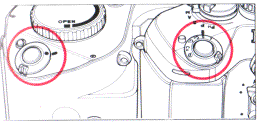 |
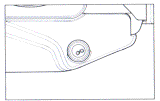 |
Note*: Remote-control operation is possible with Nikon Remote Cord MC-12 or MC-12A via the remote terminal on the MB-21B/MB-22B base portion. |
Exposure Meter in the Camera As with the shutter release on the camera body, by lightly pressing the MF-24's shutter release button you can activate the light metering circuit and exposure information inside the camera's viewfinder After removing your finger from the button, the light metering circuit and exposure information stay on for 16 seconds. (For details. see your camera instruction manual.)
 |
In aperture-priority auto (A) or manual (M) exposure, mode, the aperture value displayed on the MF-24'. LCD panel may differ from that displayed inside the camera's viewfinder. |
Instruction how to use the MF-24's
data imprinting function and other multi functions.
CONTROL BUTTONS
SETTING IMPRINT DATA
IMPRINT LEVEL ADJUSTMENT
DATA IMPRINTING
INTERVAL TIMER FUNCTION
EXPOSURE DELAY FUNCTION
LONG TIME EXPOSURE FUNCTION
DAILY ALARM FUNCTION
FREEZE FOCUS (FOCUS PRIORITY) FUNCTION
FILM ALARM FUNCTION
FILM STOP FUNCTION
AUTO EXPOSURE BRACKETING
COMBINING MF-24'S FUNCTIONS
CONTROL BUTTONS ![]()
FNC (FUNCTION) Button Pressing the button lets you select the following MF-24 functions
in this order~ Between-Frames Data Imprint- In-Frame Data Imprint-Imprint Level Adjust-
Interval Timer Exposure Delay-Long Time Exposure-Daily Alarm-Freeze Focus (Focus
Priority)-Film Alarm-Film Stop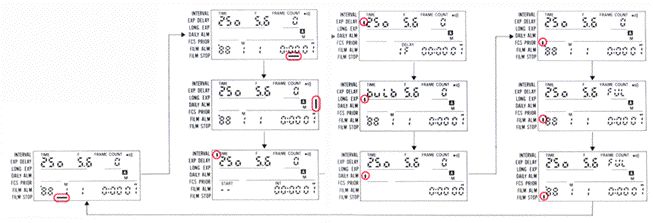
![]() MOD (MODE) Button Pushing MOD button
causes display to alternate between the following selections within each function.
MOD (MODE) Button Pushing MOD button
causes display to alternate between the following selections within each function.
Between-Frames Data Imprint function: Year/Month/Day-
Day/ Hour/ Minute/(Second) - Fixed Number - Frame Count-Shutter Speed/Aperture-Exposure
Compensation Value (for Auto Bracketing-Blank
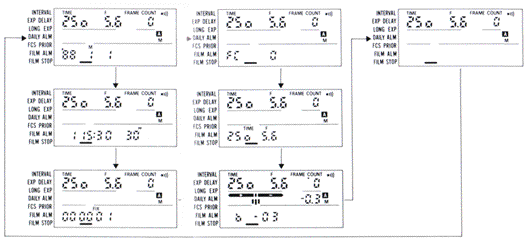
In-Frame Data Imprint function'. Year/Month/Day-Month/
Day/Year -Day/Month/Year- Day/Hour/Minute- Hour/Minute/Second- Frame Count -Sequence
Number-Fixed Number -Blank
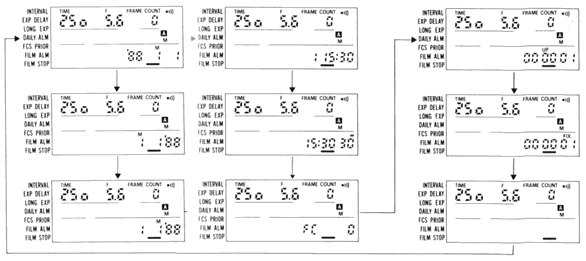
Interval Timer function: Start Time (Day/Hour/Minute)/Interval Time (Hour/Minute/Second)-Frames per shooting/number of shootings -Imprinted Data
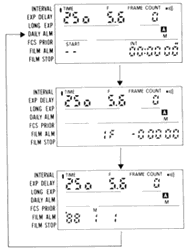 |
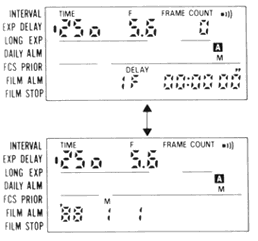 |
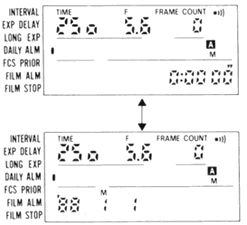 |
|
| Exposure Delay function: Frames per shooting/remaining time -Imprinted Data |
Daily Alarm function: Alarm time (Hour/Minute/Second)-Imprinted Data |
 |
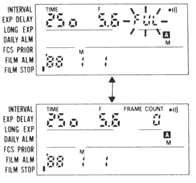 |
Film Alarm function: Number of frames- Frame count |
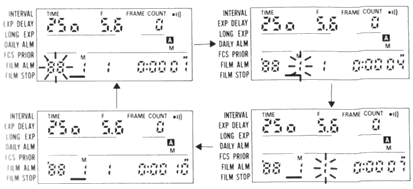 |
|
|
|
 |
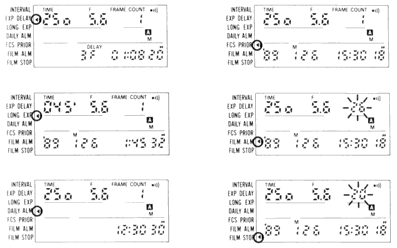 |
|
 |
|
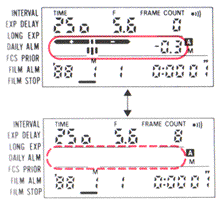 |
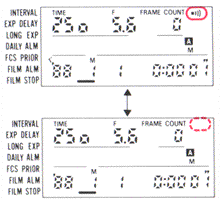 |
|
| Previous | NEXT | 3/7 Setup the Filmback and Operation Sequences
| Click Open a new window for MAIN REFERENCE MAP on the Multi-Control databack MF-24 |
| MF-22 Databack | MF-23 Multi-Control Function Databack | MF-24 250 Exposures Multi-Control Function Databack (overview) | NPC Polaroid Back | Relative: | MB-21 High Speed Power Pack | MB-22 External Power Regulator | MB-23 Multi-Power High Speed Power Pack |
Relative: Prisms for Nikon F Series | Finders Group for Nikon F2 Series | Viewfinders for Nikon F3 Series | Nikon F3AF's DX-1 AF finder
The Camera Body - Features | Reliability | Focusing | Metering | Exposure Control | Lense Compatibility | Interchangeable Prisms | Data Film Backs | Various Power Sources | Focusing Screens | Flash Photography | Other system accessories | Cases for Nikon F4 Series | Remote Control |
| Specification | Main Reference Map | Instruction Manual: PDF (4.5M) - External Link
| BACK | to Main Index Page of 250 exp. Multi-Control
databack MF-24
| BACK
| to Main Index Page Nikon F4 Series SLR camera
Models
| Message
Board
| for Nikon F4 Series SLR model(s)
| Message
Board
| for your Nikon
Optics in a shared environment
| Message
Board
| Specifically
for Dispose or Looking for Nikon/Nikkor
Photographic Equipment
| Nikon F | Nikon F2 | Nikon F3 | Nikon F4 | Nikon F5 | Nikon F6 | Nikkormat / Nikomat | Nikon FM | Nikon FE/ FA | Nikon EM/FG/FG20 | Nikon Digital SLRs | Nikon - Other models |
Nikon Auto Focus Nikkor lenses:- Main
Index Page
Nikon Manual
Focus
Nikkor lenses:- Fisheye-Nikkor Lenses - Circular | Full Frame |
Ultrawides Lenses - 13mm15mm18mm20mm | Wideangle Lenses - 24mm28mm35mm | Standard Lenses - 45mm 50mm 58mm | Telephoto
Lenses - 85mm105mm135mm180mm & 200mm | Super-Telephoto Lenses - 300mm 400mm 500mm 600mm 800mm 1200mm |
 Index Page |
Special
Application lenses: Micro-Nikkor Lenses - 50mm~55mm -60mm 85mm -105mm 200mm Micro-Zoom 70-180mm Perspective Control (PC) - 28mm 35mm PC-Micro 85mm Dedicated Lenses for Nikon F3AF: AF 80mm f/2.8 | AF 200mm f/3.5 EDIF Depth of Field Control (DC): 105mm 135mm Medical Nikkor: 120mm 200mm Reflex-Nikkor Lenses - 500mm 1000mm 2000mm Others: Noct Nikkor | OP-Nikkor | UV Nikkor 55mm 105mm | Focusing Units | Bellows-Nikkor 105mm 135mm Nikon Series E Lenses: 28mm35mm50mm100mm135mm | E-Series Zoom lenses: 36~72mm75~150mm70~210mm |
MF Zoom-Nikkor Lenses: 25~50mm | 28~45mm | 28~50mm | 28~85mm | 35~70mm | 36~72mm E | 35~85mm | 35~105mm | 35~135mm | 35~200mm | 43~86mm | 50~135mm | 50~300mm | 70~210mm E | 75~150mm E | 80~200mm | 85~250mm | 100~300mm | 180~600mm | 200~400mm | 200~600mm | 360~1200mm | 1200~1700mm
Tele-Converters: TC-1 | TC-2 | TC-200 | TC-201 | TC-300 | TC-301 | TC-14 | TC-14A | TC-14B | TC-14C | TC-14E | TC-16 | TC-16A | TC-20E
Recommended links to understand more technical details
related to the Nikkor F-mount and production Serial Number:
http://rick_oleson.tripod.com/index-153.html by: my
friend, Rick Oleson
http://www.zi.ku.dk/personal/lhhansen/photo/fmount.htm by: Hansen,
Lars Holst
http://www.mir.com.my/rb/photography/hardwares/nikonfmount/lens2.htm
http://www.photosynthesis.co.nz/nikon/serialno.html
HOME - Photography in Malaysia |
Credit: Chuck Hester, US for his patience, encouragement and help to setup the various content in this site; Robert Johnson for some of his original images on the F2H-MD appeared in this site; my ex-staff, KiaSu for his superb 3-D logo appeared in this Nikon F2 site; Marc Vorgers from Holland who generously provide me with some of his images of F2AS; MCLau®, who has so much time with me to re-edit the content in this site and not to mention buying a Nikon Coolpix 990 just for this site; Paul Armstrong (pkared@ameritech.net) for his explantion of the FF2 Slidemagic and Nikon F2 Pin Camera Keat Photo, Kuala Lumpur for providing their Nikon F2A to take some images for this site; Mr Edward Ngoh the great camera collector who provides us his collection of F2AS with MD-2; hawkeye.photographic.com for their images on the Speed Magny film backs; Sean Cranor for his image on Nikon F2 25th Anniversary Model; Ted Wengelaar®, Holland for his continuous flow of input on some of the early Nikon bodies; Genesis-Camera for granting permission to use an image of the SS-F2 camera; Mr Sover Wong, Australia for those great images of his rare F2 Gold;CYLeow ®, photo editor of the Star newspaper, Malaysia for some of his images used in this site. Ms Rissa Chan, Sales manager from Shriro Malaysia who has helped to provide some of the very useful input. HiuraShinsaku®, Nikomat ML, Japan for some of his images on various F2 models; my staff, Wati, Maisa, Mai and my nephew, EEWyn®, who volunteered and helping me did so many of the film scanning works; Hong-sien Kwee of Singapore for all the Nikon F2 Pin camera images appeared in this site; Luigi Crescenzi for many of his images on the Nikon F2 Titan; John for two of his images of the Nikon F2/T used in this site; Contributing photographers or resellers: Jen Siow, Foo KokKin, Arthur Teng, Mark Fallander, John Ishii, Ed Hassel, YoonKi Kim, Jean-Louis, M.Dugentas (Dell Corner.com.), Mr "Arsenall", Yang Zi Xiong and a few images mailed in from surfers with no appropriate reference to their origin. Note:certain content and images appeared in this site were either scanned from official marketing leaflets, brochures published by Nikon and/or contribution from surfers who claimed originality of their own work to publish in this site based on educational merits. The creator of this site will not be responsible for any discrepancies that may arise from such possible dispute except rectifying them after verification."Nikon", "Nikkormat", "Nippon Kokagu KK" & "Nikkor" are registered tradename of Nikon Corporation Inc., Japan. A site made with an Apple IMac.
